Cervical spondylosis is the result of a sedentary lifestyle and poor nutrition. The first signs of the disease can appear as early as the age of 25. If treatment is not started, serious complications will arise. In the treatment of the disease, an integrated approach is used - drug treatment, dietary therapy, physiotherapy and physiotherapy.
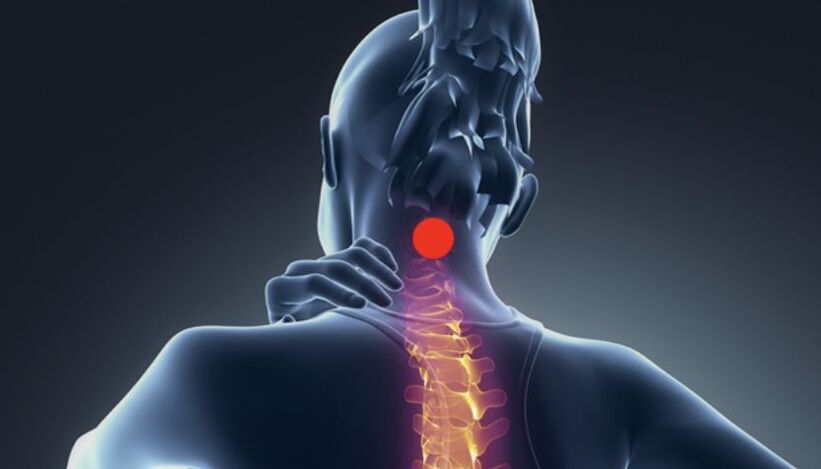
Causes of cervical spondylosis
Cervical cartilage degeneration is degenerative-dystrophic changes in the intervertebral discs and joints, leading to reduced neck mobility and severe pain. The main cause of the development of the disease is mineral metabolism disorders, causing bones and joints to become less strong. ICD-10 codes – M42, M50–54.
Why does cervical spondylosis occur?
- overweight, sedentary lifestyle;
- poor posture, scoliosis;
- Rheumatism;
- flat feet;
- VSD;
- poor nutrition.
Injuries, bruises in the spine, excessive physical activity and stress can cause the development of deformities of the cervical vertebrae. In women, cartilage degeneration often occurs during pregnancy and menopause - due to hormonal changes, calcium levels decrease, bone tissue becomes fragile.
Important! The tendency to develop osteonecrosis is hereditary.
General symptoms and signs
With constantly increased load on the cervical vertebrae, muscle spasms occur, the vessels of the cervical spine are compressed, blood circulation is interrupted, metabolic processes are interrupted - the structure of the intervertebral discs changes, they become deformed and begin to protrude beyond the spine.
How does osteoarthritis of the cervical spine manifest:
- nerve root syndrome - due to compression of nerve endings, pain occurs that spreads from the neck to the shoulder blades, forearms and covers the front wall of the chest;
- muscle weakness in the arms, marked neck swelling;
- when you move your head, you will hear a characteristic crunching sound;
- asthenia, chronic fatigue, changes in blood pressure;
- lack of coordination, often dizziness, attacks accompanied by nausea and vomiting;
- visual and hearing impairment, noise, tinnitus;
- numbness of limbs and tongue;
- frequent migraines;
- In women aged 45–65 years, pain, numbness and tingling in the upper limbs appear during sleep, and the attacks may repeat several times during the night.
With cervical spondylosis, the supply of nutrients and blood to the brain is interrupted, neurological disorders occur - anxiety, irritability, mood changes, sleep disorders.
Classification of cervical spondylosis
As osteochondrosis develops, it goes through several stages of development, each of which has characteristic signs. You can see in the photo what the affected part of the spine looks like at different stages.
Degree of disease development:
- Grade 1 osteonecrosis - the first stage occurs without particularly obvious symptoms, the patient feels uncomfortable because of mild and rare pain when turning and tilting the head, the back muscles quickly tire.
- Grade 2 osteoarthritis - unstable vertebrae, pinched nerves, discomfort in the neck becomes noticeable, spreading to the shoulders and arms. Other symptoms are increasing fatigue, frequent headaches in the occipital region, and absent-mindedness.
- Osteoarthritis grade 3 - the pain becomes chronic, covers the upper back, arms, severe muscle weakness, numbness of the limbs, intervertebral herniation and often attacks of vertigo occur.
- Grade 4 osteonecrosis - complete destruction of intervertebral discs occurs, they are replaced by connective tissue, the pathological process covers several segments of the spine. Lacking coordination, vertigo attacks become more frequent and tinnitus appears.
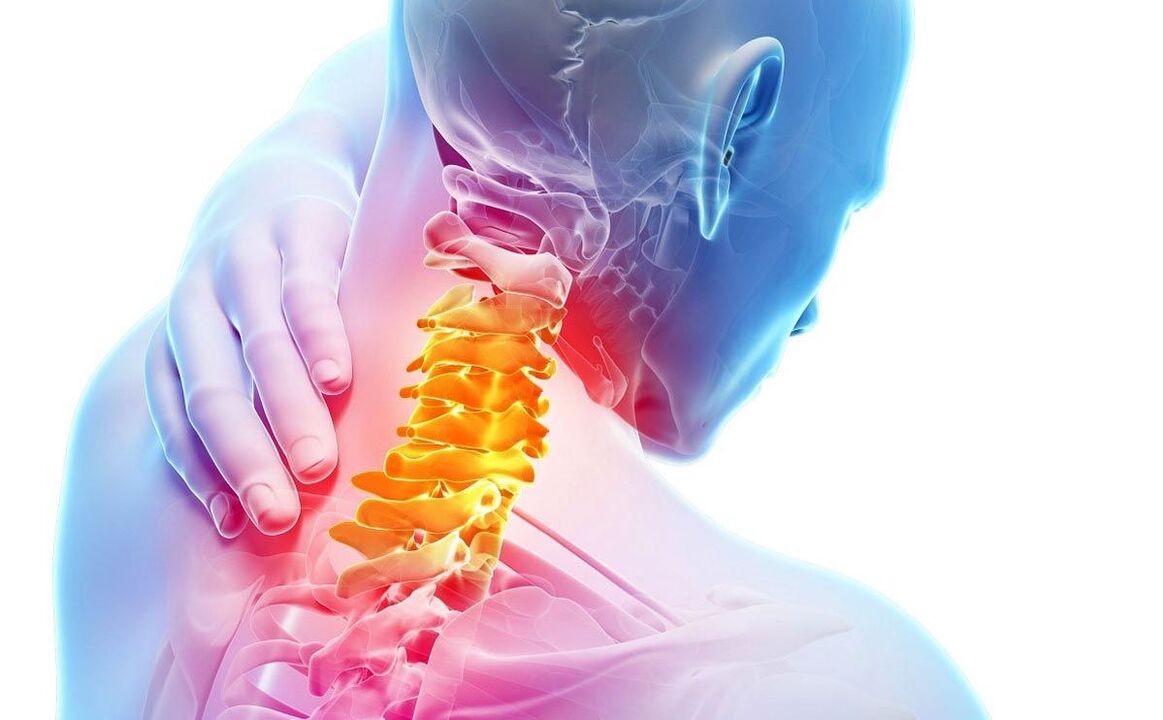
Acute osteoarthritis is a consequence of the chronic form of the disease, characterized by severe sharp pain that occurs suddenly after waking up.
Which doctor should I contact?
If signs of cervical spondylosis appear, you need to see a neurologist, some hospitals have a vertebra specialist - a doctor who specializes in treating diseases of the spine.
Diagnostic method
Advanced forms of osteoarthritis have a pronounced clinical picture, allowing the initial diagnosis to be made at the first examination. Instrumental diagnostic methods will help determine the degree of degenerative changes in the vertebrae.
Main types of tests for osteoarthritis:
- X ray- this method is effective only at the early stages of pathological development;
- MRI– the structure of the bone structure, the size and direction of development of the intervertebral hernia, the condition of the spinal cord are clearly visible on the screen;
- CT– this method is less effective than MRI because it does not provide accurate information about the presence and size of the hernia;
- double-sided scanning– allows you to see blood flow disorders;
- electricity– indicates the presence of compression, inflammation and other nerve damage;
- brain scan– prescribed for problems with blood supply to the brain.
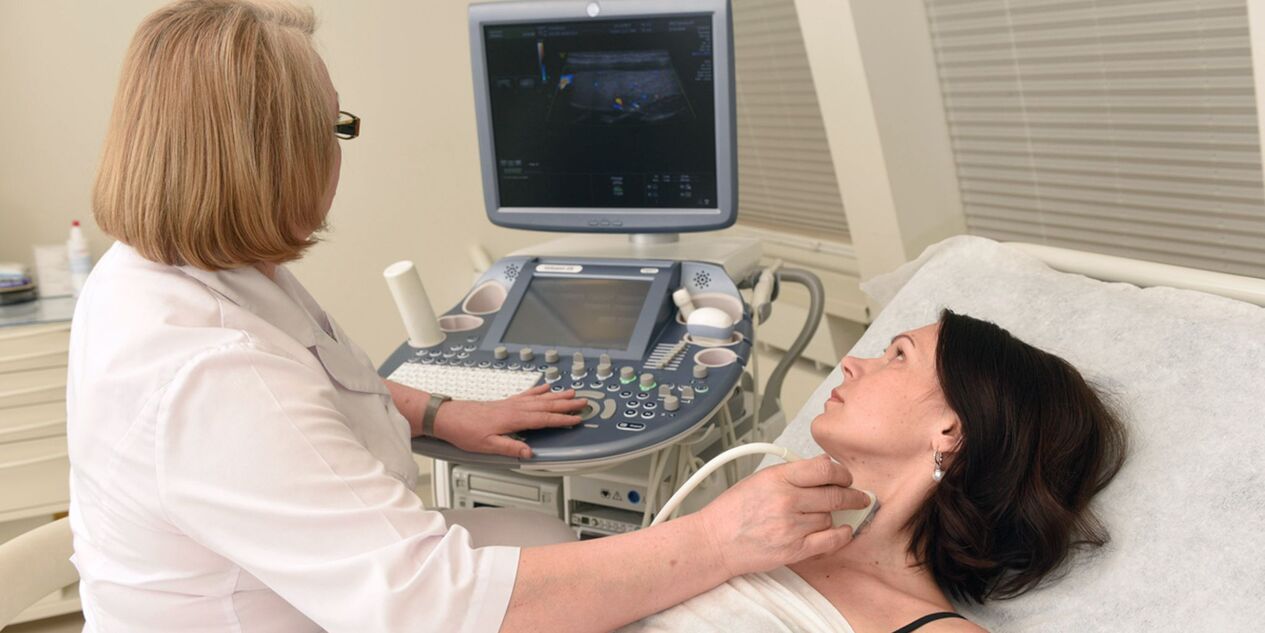
For a targeted and thorough study of the condition of certain vertebrae, discography is performed - a contrast agent is injected into the disc, allowing you to see the slightest changes in the tissuesand differentiate scarring changes from hernias.
Treatment methods for cervical spondylosis
At the initial stages of development, osteoarthritis can be cured without medication, simply reviewing the diet, daily habits and regularly performing a series of exercises, especiallyenough. In advanced forms of the disease, effective treatment is possible only with the use of various drugs that help prevent degenerative changes in the vertebrae.
The complexity of treatment measures necessarily includes physical procedures - electrophoresis with drugs, ultrasound, magnetic therapy, laser therapy. These methods help to cope with pain, inflammation, tissue swelling, improve metabolism and blood circulation.
First aid
Pain relievers will help reduce pain caused by osteoarthritis. You can warm the affected area with mustard plaster or pepper plaster.
To reduce swelling of inflamed tissues, drink rosehip decoction and other diuretics. Massaging the inflamed area with ice cubes will help relieve severe pain in the neck, continue doing this until the skin turns slightly red.
Physical therapy
Exercise therapy is indicated during recovery; during exacerbation of osteoarthritis, exercise is contraindicated; Gymnastics is very simple, you can practice at home and need to practice regularly.
Bubnovsky's gymnastics for the treatment and prevention of cervical spondylosis:
- In a standing position, relax your arms along your body. Tilt your head forward, try to touch your chin to your chest, fix the position, count to 3. Tilt your head back, chin look up, count to 3. Return to the starting position.
- In a standing position, turn your head to the right and left and fix the position at each extreme point for a few seconds. Repeat 3 times on each side.
- In a standing position, tilt your head to the right, left, try to touch your ear to your shoulder and maintain the position for 30 seconds. Do 6 repetitions in each direction.
- Stand, hands placed on the waist, chin parallel to the floor, stretched straight forward. Turn your head, rest your chin on your shoulder, rotate your body a little, hold for half a minute. Perform 6 repetitions in each direction, slight pain in the spine may occur.
- In a sitting position, back straight, hands placed on knees. Straighten your arms to the sides, step back a bit, and at the same time tilt your head back, return to the starting position, repeat 5 times.
- In a sitting position, turn your head to the right, place your left palm on your right shoulder, your elbow parallel to the floor, your right hand on your knee, return to the starting position. Do 6 repetitions in each direction.
- In a sitting position, raise your hands above your head, tightly connected, slightly bend your elbows, turn your head to the side until a slight pain appears, fix the position at the extreme point for a few seconds. Repeat 6 times in each direction.
Rest 30 seconds between exercises. Before starting to exercise, you need to take a warm bath and make gentle head tilts in different directions to warm up your muscles. After completing the exercise, light stretching will help you avoid discomfort the next day.
Treatment medicine
Drug treatment for osteoarthritis is aimed at eliminating discomfort, restoring mobility of the vertebrae and slowing down the degeneration of tissues. Acute pain is relieved with NSAID or corticosteroid injections, while the chronic form of the disease is treated with ointments and pills.
How to treat osteoarthritis:
- NSAIDs– produced in the form of tablets and products for external use, effective in reducing swelling and pain;
- corticosteroids- reduces acute pain syndrome;
- B vitamins- restores metabolic processes in tissues;
- chondroprotector– promotes cartilage tissue recovery;
- The drug improves blood flow and brain nutrition;
- nootropics- improves brain function and memory;
- muscle relaxants- eliminates muscle spasms;
- For local treatment, ointments and gels with anti-inflammatory, warming effects are used..
For drug treatment to be effective, it must be combined with exercise therapy and compliance with a diet, otherwise no drug will help get rid of osteonecrosis.
Important! If conservative treatment is ineffective, surgery will be indicated.
Folk remedies
Traditional treatments should be used as a complement to drug therapy and exercise, unconventional methods will not help completely eliminate the disease.
What to do when you have cervical spondylosis at home:
- Pour boiling water over fresh horseradish leaves, let cool slightly, apply the inner side to the neck, securing with a thin natural cloth. Perform the procedure before going to bed, apply the compress throughout the night.
- Grind raw potatoes on a fine blender and mix in equal proportions with warm liquid honey. Use the mixture for compresses, perform the procedure 1-2 times a week.
- Mix one raw egg with 100 ml of sunflower oil, 20 ml of vinegar and 20 g of flour, leave the mixture in a dark place for 48 hours, remove the film on the surface. Apply the product to the inflamed skin area before going to bed and store in the refrigerator.
- In May, collect pine buds up to 2 cm long, cut into thin slices and put in a dark glass container. Take 1 part of ingredients and 2 parts of sugar, leave the medicine in a dark place for 2 weeks. Drink 5 ml of the mixture three times a day, do not swallow immediately, keep it in your mouth for 2-3 minutes. Course duration is 15–20 days, repeated 2–3 times a year.
- Grind 150 g of peeled garlic and 400 g of cranberries, put the mixture in a glass container, after 24 hours add 800 ml of honey, stir well. Take 5 ml of the medicine three times a day before meals.

Cabbage leaves smeared with honey will help relieve severe pain and absorb excess salt. Fix the compress on your neck with a warm towel and leave overnight.
Massage to treat cervical spondylosis
Massage helps to increase muscle tone, improve blood circulation in tissues, in severe cases of osteoarthritis, therapy sessions are carried out by a specialist. In mild forms of the disease, self-massage will help with prevention - treatment is carried out at home.
Massage techniques:
- Warm up your muscles– Use both hands, run vigorously along the back and side of the neck from top to bottom. Warm-up time: 2 minutes.
- Press the edge of your palm against the bottom of your neck,Move in a sliding motion to the hair growth area, then to the shoulder joint.
- Make a circular rubbing motion with the fingertips of both handsin the occipital region from the hairline to the forearm - from the spine to the ears and back.
- Pinch the neck muscles from bottom to top, then in the opposite direction.
- Caress from the back of the head to the shoulder blades– done after each type of exercise.
Important! Do not massage protruding vertebrae, lymph nodes or carotid arteries.
Diet
The purpose of a diet for osteoarthritis is to provide the body with collagen and protein; These substances participate in the synthesis of cartilage tissue; Most of them are found in aspic, jelly fish and jelly.
| Prohibited products | Authorized product |
|
|
Important! To avoid dehydration of disc tissue, you need to drink at least 2. 5 liters of pure water every day.
Possible consequences and complications
In the neck region, the vertebrae are located close to each other and the height of the intervertebral discs is small, so many complications of osteoarthritis occur even when there are small degenerative changes in bone tissue.
Why is cervical spondylosis dangerous?
- frequent migraines;
- arrhythmia, atherosclerosis;
- bony protrusion, intervertebral herniation, vertebral bone development;
- severe encephalopathy;
- narrowing of the vertebral artery lumen, leading to the development of VSD, cerebral hypertension and disability;
- spinal stroke.
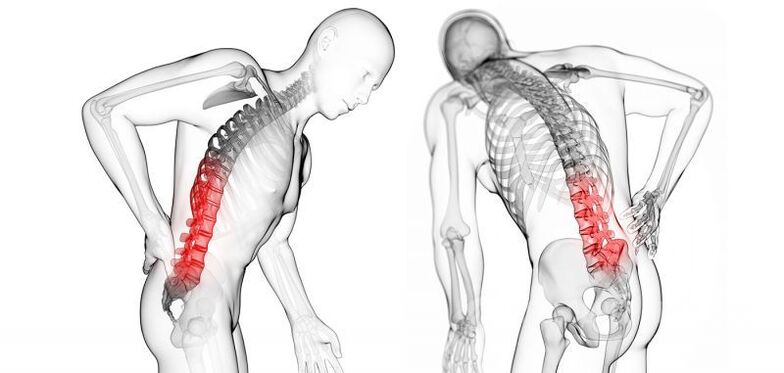
Important! With progressive osteonecrosis, spinal cord compression occurs, which can cause death.
Contraindicated for cervical spondylosis
To live a fulfilling life with osteoarthritis, you need to avoid actions that can cause pain and make the disease worse.
Things not to do when suffering from cervical spondylosis:
- Sleep on a very hard or soft mattress, on high pillows;
- Lifting weights, if you need to lift heavy objects, you must do it with a straight back and bent knees;
- carry bag on one shoulder;
- When the pathology becomes more severe, actively move your head and neck;
- smoking, drinking alcohol;
- walking without a scarf when it's cold, sitting in a drafty place, near an air conditioner;
- being in an uncomfortable position for a long time, sitting;
- wear high heels;
- break your neck.
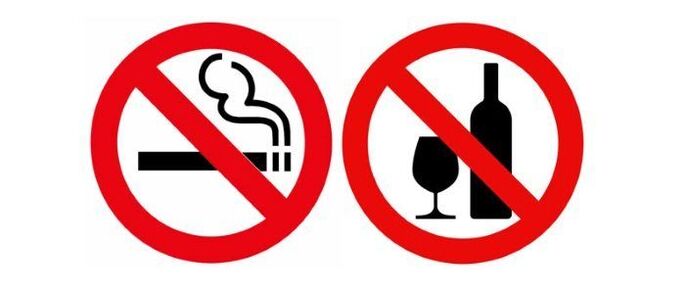
Hot compress procedures - warm compresses, going to the bathroom, warming with a blue light - can be carried out only during the period of remission of the disease. During an exacerbation, applying heat will only relieve the pain for a short time, but soon the unpleasant sensations will return and the degree of their manifestation will increase.
Disease prevention
To maintain the health of the spine, it is enough to follow simple rules of prevention.
How to avoid cervical spondylosis:
- remove excess weight;
- Exercise every morning, go swimming, do yoga, dance;
- spend a lot of time outdoors, morning walks are especially useful;
- Eat a reasonable diet, control salt intake, follow a water drinking regimen;
- When working sedentary, warm up your neck every hour and pay attention to your posture;
- keep your neck warm;
- Get enough sleep to avoid physical, mental and emotional fatigue.
Sleep properly. You should only rest your head, neck and shoulders on pillows on the mattress, and put a small cushion under your feet. It is better to sleep on your back or in the fetal position. In case of more severe disease, you should only lie on your side. Orthopedic mattress, moderate hardness, rectangular pillow, orthopedic, 15–20 cm high, correct sleeping position, straight spine, different parts are not misaligned, muscles are relaxed.
Cervical spondylosis is a chronic disease, progressing slowly, and signs of the disease do not appear immediately. An effective combination of traditional and folk treatments, exercise and diet will help to cope with unpleasant symptoms, while simple preventive measures will help avoid recurrence of the diseasephysical.

























